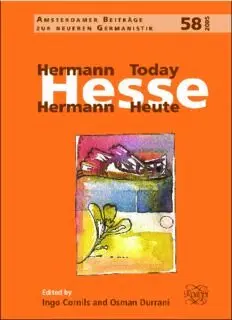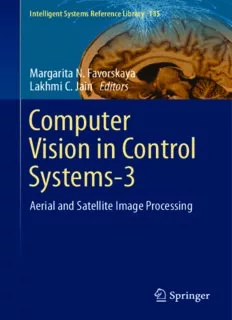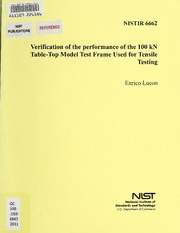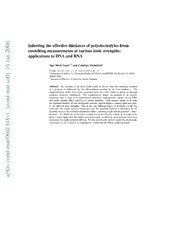
Mathematics of Fuzzy Sets and Fuzzy Logic PDF
Preview Mathematics of Fuzzy Sets and Fuzzy Logic
Studies in Fuzziness and Soft Computing 295 Editor-in-Chief Prof.JanuszKacprzyk SystemsResearchInstitute PolishAcademyofSciences ul.Newelska6 01-447Warsaw Poland E-mail:kacprzyk@ibspan.waw.pl Forfurthervolumes: http://www.springer.com/series/2941 Barnabas Bede Mathematics of Fuzzy Sets and Fuzzy Logic ABC Author BarnabasBede DepartmentofMathematics DigiPenInstituteofTechnology Redmond,WA USA ISSN1434-9922 e-ISSN1860-0808 ISBN978-3-642-35220-1 e-ISBN978-3-642-35221-8 DOI10.1007/978-3-642-35221-8 SpringerHeidelbergNewYorkDordrechtLondon LibraryofCongressControlNumber:2012953384 (cid:2)c Springer-VerlagBerlinHeidelberg2013 Thisworkissubjecttocopyright.AllrightsarereservedbythePublisher,whetherthewholeorpartof thematerialisconcerned,specificallytherightsoftranslation,reprinting,reuseofillustrations,recitation, broadcasting,reproductiononmicrofilmsorinanyotherphysicalway,andtransmissionorinformation storageandretrieval,electronicadaptation,computersoftware,orbysimilarordissimilarmethodology nowknownorhereafterdeveloped.Exemptedfromthislegalreservationarebriefexcerptsinconnection with reviews or scholarly analysis or material supplied specifically for the purpose of being entered and executed on a computer system, for exclusive use by the purchaser of the work. Duplication of this publication or parts thereof is permitted only under the provisions of the Copyright Law of the Publisher’slocation,initscurrentversion,andpermissionforusemustalwaysbeobtainedfromSpringer. PermissionsforusemaybeobtainedthroughRightsLinkattheCopyrightClearanceCenter.Violations areliabletoprosecutionundertherespectiveCopyrightLaw. Theuseofgeneraldescriptivenames,registerednames,trademarks,servicemarks,etc.inthispublication doesnotimply,evenintheabsenceofaspecificstatement,thatsuchnamesareexemptfromtherelevant protectivelawsandregulationsandthereforefreeforgeneraluse. Whiletheadviceandinformationinthisbookarebelievedtobetrueandaccurateatthedateofpub- lication,neithertheauthorsnortheeditorsnorthepublishercanacceptanylegalresponsibilityforany errorsoromissionsthatmaybemade.Thepublishermakesnowarranty,expressorimplied,withrespect tothematerialcontainedherein. Printedonacid-freepaper SpringerispartofSpringerScience+BusinessMedia(www.springer.com) Dedicated to my daughters: Fruzsina and Tekla Preface The present manuscript is intended to be a textbook that could serve both undergraduate and graduate students when studying Fuzzy Set Theory and Applications. It is also intended to deepen the research into some existing directions and to investigate some new research directions. The book tries to develop a systematic, Mathematically-based introduction into the theory and applications of fuzzy sets and fuzzy logic. In this way the author tries to cover a gap in the literature. Also, the book can be an introduction into Fuzzy Sets and Systems for researchers who are interested in the topic of fuzzy sets in all areas of Mathematics, Computer Science and Engineering, or simply interested Mathematicians, Engineers and students in these areas. The book starts from the basic theory and gets the reader to a level very close to the current researchtopics in Fuzzy Sets. The basis ofthe book is the author’sclass notes for Fuzzy Sets and Fuzzy Logic, class taught at DigiPen Institute of Technology. Another goal that the author had when writing the presentbook is try to see where Fuzzy Sets and Fuzzy Logic as a discipline, can be connected to other areas of Mathematics. The manuscript tries to show that Fuzzy Sets is an independent discipline having huge overlaps on one side with Analysis andApproximationTheoryandontheothersidewithLogicandSetTheory. The approach of the present work leans toward Mathematical Analysis and Approximation. I am really thankful to my wife Emese, who providedverystrong support formeinwritingthisbook.Also,the authoris thankfultohis colleagues,es- pecially Sorin G. Gal, L. Stefanini, L.C. Barros, I.J. Rudas and many others forcommentsthatimprovedthemanuscript.Theauthorwouldliketoexpress VIII Preface histhankstoallthestudentswhocontributedwithcommentsthatimproved the manuscript, especially Kia McDowel, Matt Peterson, Chris Barrett, and many others. Barnabas Bede Redmond, WA Contents 1 Fuzzy Sets 1 1.1 Classical Sets . . . . . . . . . . . . . . . . . . . . . . . . . . . 1 1.2 Fuzzy Sets . . . . . . . . . . . . . . . . . . . . . . . . . . . . . 2 1.3 The Basic Connectives . . . . . . . . . . . . . . . . . . . . . . 5 1.3.1 Inclusion . . . . . . . . . . . . . . . . . . . . . . . . . 6 1.3.2 Intersection . . . . . . . . . . . . . . . . . . . . . . . . 6 1.3.3 Union . . . . . . . . . . . . . . . . . . . . . . . . . . . 6 1.3.4 Complementation. . . . . . . . . . . . . . . . . . . . . 6 1.4 Fuzzy Logic . . . . . . . . . . . . . . . . . . . . . . . . . . . . 9 1.5 Problems . . . . . . . . . . . . . . . . . . . . . . . . . . . . . 11 2 Fuzzy Set-Theoretic Operations 13 2.1 Negation. . . . . . . . . . . . . . . . . . . . . . . . . . . . . . 13 2.2 Triangular Norms and Conorms . . . . . . . . . . . . . . . . . 16 2.3 Archimedean t-Norms and t-Conorms . . . . . . . . . . . . . 19 2.4 Fuzzy Implications . . . . . . . . . . . . . . . . . . . . . . . . 24 2.5 Fuzzy Equivalence . . . . . . . . . . . . . . . . . . . . . . . . 27 2.6 Problems . . . . . . . . . . . . . . . . . . . . . . . . . . . . . 28 3 Fuzzy Relations 33 3.1 Fuzzy Relations . . . . . . . . . . . . . . . . . . . . . . . . . . 33 3.2 Max-Min Composition . . . . . . . . . . . . . . . . . . . . . . 34 3.3 Min-Max Composition . . . . . . . . . . . . . . . . . . . . . . 36 3.4 Min → Composition . . . . . . . . . . . . . . . . . . . . . . . 38 X Contents 3.5 Fuzzy Relational Equations with Max-Min and Min → Compositions . . . . . . . . . . . . . . . . . . . . . . . . . . . 40 3.6 Max-t-Norm Composition . . . . . . . . . . . . . . . . . . . . 43 3.7 Min → Composition . . . . . . . . . . . . . . . . . . . . . . 44 T 3.8 Fuzzy Relational Equations with Max-t-Norm and Min → T Compositions . . . . . . . . . . . . . . . . . . . . . . . . . . . 45 3.9 Problems . . . . . . . . . . . . . . . . . . . . . . . . . . . . . 47 4 Fuzzy Numbers 51 4.1 Definition of Fuzzy Numbers . . . . . . . . . . . . . . . . . . 51 4.2 Characterization Theorems for Fuzzy Numbers . . . . . . . . 56 4.3 L-R Fuzzy Numbers . . . . . . . . . . . . . . . . . . . . . . . 59 4.4 Problems . . . . . . . . . . . . . . . . . . . . . . . . . . . . . 63 5 Fuzzy Arithmetic 65 5.1 Zadeh’s Extension Principle . . . . . . . . . . . . . . . . . . . 65 5.2 The Sum and Scalar Multiplication . . . . . . . . . . . . . . . 69 5.3 The Product of Two Fuzzy Numbers . . . . . . . . . . . . . . 70 5.4 Difference of Fuzzy Numbers . . . . . . . . . . . . . . . . . . 73 5.5 Problems . . . . . . . . . . . . . . . . . . . . . . . . . . . . . 77 6 Fuzzy Inference 79 6.1 Linguistic Variables. . . . . . . . . . . . . . . . . . . . . . . . 79 6.2 Fuzzy Rules . . . . . . . . . . . . . . . . . . . . . . . . . . . . 81 6.3 Fuzzy Rule Base . . . . . . . . . . . . . . . . . . . . . . . . . 83 6.4 Fuzzy Inference . . . . . . . . . . . . . . . . . . . . . . . . . . 86 6.5 The Interpolation Property of a Fuzzy Inference System . . . 88 6.6 Example of a Fuzzy Inference System . . . . . . . . . . . . . 98 6.7 Problems . . . . . . . . . . . . . . . . . . . . . . . . . . . . . 101 7 Single Input Single Output Fuzzy Systems 105 7.1 Structure of a SISO Fuzzy System . . . . . . . . . . . . . . . 106 7.1.1 Fuzzification . . . . . . . . . . . . . . . . . . . . . . . 106 7.1.2 Fuzzy Rule Base . . . . . . . . . . . . . . . . . . . . . 107 7.1.3 Fuzzy Inference . . . . . . . . . . . . . . . . . . . . . . 107 7.1.4 Defuzzification . . . . . . . . . . . . . . . . . . . . . . 107 7.2 Fuzzy Inference and Rule Base for a SISO Fuzzy System . . 108 7.3 Approximation Properties of SISO Fuzzy Systems . . . . . . 113 7.3.1 ApproximationbyMamdani,Larsenandt-NormBased SISO Fuzzy Systems . . . . . . . . . . . . . . . . . . . 114 7.3.2 Approximation by SISO Fuzzy System of Go¨del and G¨odel Residual Types . . . . . . . . . . . . . . . . . . 118 7.4 Takagi-Sugeno Fuzzy System . . . . . . . . . . . . . . . . . . 123 7.5 Approximation Properties of Takagi-Sugeno Fuzzy Systems . 125 7.6 Fuzzy Control . . . . . . . . . . . . . . . . . . . . . . . . . . . 129 Contents XI 7.7 Example of a Fuzzy Controller . . . . . . . . . . . . . . . . . 130 7.8 Problems . . . . . . . . . . . . . . . . . . . . . . . . . . . . . 134 8 Fuzzy Analysis 137 8.1 Metric Spaces of Fuzzy Numbers . . . . . . . . . . . . . . . . 137 8.2 Completeness . . . . . . . . . . . . . . . . . . . . . . . . . . . 140 8.3 Compactness . . . . . . . . . . . . . . . . . . . . . . . . . . . 144 8.4 Separability . . . . . . . . . . . . . . . . . . . . . . . . . . . . 147 8.5 Norm of a Fuzzy Number . . . . . . . . . . . . . . . . . . . . 150 8.6 Embedding Theorem for Fuzzy Numbers . . . . . . . . . . . . 151 8.7 Fuzzy Numbers with Continuous Endpoints of the Level Sets . . . . . . . . . . . . . . . . . . . . . . . . . . . . . 152 8.8 Integration of Fuzzy-Number-Valued Functions . . . . . . . . 154 8.9 Differentiability of Fuzzy-Number-Valued Functions . . . . . 157 8.9.1 Hukuhara Differentiability . . . . . . . . . . . . . . . . 157 8.9.2 Generalized Differentiabilities . . . . . . . . . . . . . . 159 8.10 Problems . . . . . . . . . . . . . . . . . . . . . . . . . . . . . 169 9 Fuzzy Differential Equations 171 9.1 FDEs under Hukuhara Differentiability . . . . . . . . . . . . 171 9.2 The Interpretation Based on Zadeh’s Extension Principle . . 176 9.3 Fuzzy Differential Equations . . . . . . . . . . . . . . . . . . . 179 9.3.1 Existence and Uniqueness of Two Solutions . . . . . . 179 9.3.2 CharacterizationResults . . . . . . . . . . . . . . . . . 184 9.3.3 Examples of Fuzzy Differential Equations under Strongly Generalized Differentiability . . . . . . . . . 186 9.4 Problems . . . . . . . . . . . . . . . . . . . . . . . . . . . . . 189 10 Extensions of Fuzzy Set Theory 193 10.1 Lattice Valued Fuzzy Sets (L-Fuzzy Sets) . . . . . . . . . . . 193 10.2 Intuitionistic Fuzzy Sets . . . . . . . . . . . . . . . . . . . . . 194 10.3 Interval Type II Fuzzy Sets . . . . . . . . . . . . . . . . . . . 195 10.4 Fuzzy Sets of Type 2 . . . . . . . . . . . . . . . . . . . . . . . 196 10.5 Problems . . . . . . . . . . . . . . . . . . . . . . . . . . . . . 198 11 Possibility Theory 201 11.1 Fuzzy Sets and Possibility Distributions . . . . . . . . . . . . 201 11.2 Fuzzy Measures . . . . . . . . . . . . . . . . . . . . . . . . . . 202 11.3 Possibility Measures . . . . . . . . . . . . . . . . . . . . . . . 205 11.4 Fuzzy Integrals . . . . . . . . . . . . . . . . . . . . . . . . . . 206 11.5 Problems . . . . . . . . . . . . . . . . . . . . . . . . . . . . . 212 12 Fuzzy Clustering 213 12.1 Classical k-Means Clustering . . . . . . . . . . . . . . . . . . 213 12.2 Fuzzy c-Means . . . . . . . . . . . . . . . . . . . . . . . . . . 215 XII Contents 12.3 Continuous Fuzzy c-Means . . . . . . . . . . . . . . . . . . . 217 12.4 Problems . . . . . . . . . . . . . . . . . . . . . . . . . . . . . 219 13 Fuzzy Transform 221 13.1 Definition of Fuzzy Transforms . . . . . . . . . . . . . . . . . 221 13.2 Error Estimates for F-Transforms Based on Fuzzy Partitions . . . . . . . . . . . . . . . . . . . . . . . . . . . . . 225 13.3 B-Splines Based F-Transform . . . . . . . . . . . . . . . . . . 228 13.4 Shepard Kernels Based F-Transform . . . . . . . . . . . . . . 231 13.5 Korovkin Type Theorems for the F-Transform . . . . . . . . 236 13.6 F-Transform with Bernstein Basis Polynomials . . . . . . . . 239 13.7 F-Transform of Favard-Sz´asz-MirakjanType. . . . . . . . . . 242 13.8 Problems . . . . . . . . . . . . . . . . . . . . . . . . . . . . . 245 14 Artificial Neural Networks and Neuro-Fuzzy Systems 247 14.1 Artificial Neuron . . . . . . . . . . . . . . . . . . . . . . . . . 247 14.2 Feed-Forward Neural Network . . . . . . . . . . . . . . . . . . 248 14.3 Learning of a Neural Network . . . . . . . . . . . . . . . . . . 251 14.4 Approximation Properties of Neural Networks . . . . . . . . . 253 14.5 Adaptive Network Based Fuzzy Inference System (ANFIS). . 254 14.6 Problems . . . . . . . . . . . . . . . . . . . . . . . . . . . . . 258 References 259 Appendix A Mathematical Prerequisites 267 A.1 Lattices . . . . . . . . . . . . . . . . . . . . . . . . . . . . . . 267 A.2 Real Numbers . . . . . . . . . . . . . . . . . . . . . . . . . . . 269 A.3 Metric Spaces . . . . . . . . . . . . . . . . . . . . . . . . . . . 269 A.4 Continuity . . . . . . . . . . . . . . . . . . . . . . . . . . . . . 271 A.5 Modulus of Continuity . . . . . . . . . . . . . . . . . . . . . . 272 A.6 Normed Spaces . . . . . . . . . . . . . . . . . . . . . . . . . . 273 Index 275
Description:The list of books you might like

$100m Offers

Do Epic Shit

A Thousand Boy Kisses

Shatter Me Complete Collection (Shatter Me; Destroy Me; Unravel Me; Fracture Me; Ignite Me)

Centenary Magazine

Anthology of Islamic Literature : From The Rise of Islam to Modern Times

DTIC ADA456258: TREC2003 Robust, Hard and QA Track Experiments Using PIRCS

+CA EKİ, SIFATIN ANLAMINI GÜÇLENDİRİR Mİ?

Government and political life in England and France, c.1300-c.1500

Greek Government Gazette: Part 7, 2011 no. 82

Multiple Stellar Populations in Galactic GCs: Observational Evidence

Thank You for Being Such a Pain: Spiritual Guidance for Dealing with Difficult People

Hermann Hesse Today - Hermann Hesse Heute

Computer Vision in Control Systems-3: Aerial and Satellite Image Processing

Join Our Gang by Sterling E Lanier

Las unidades del discurso oral

Scarlet malachite beetle Malachius aeneus (L.) (Col.: Melyridae): Status and distribution in the UK

Notiziario ERSA 2006-1






